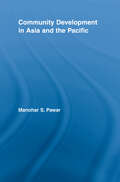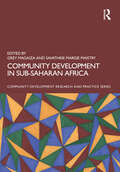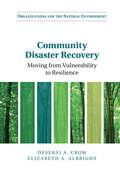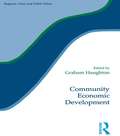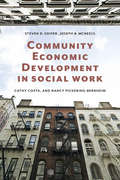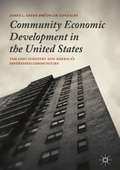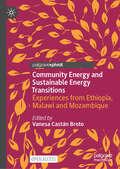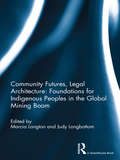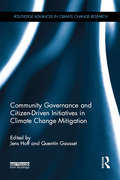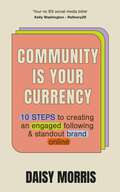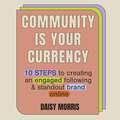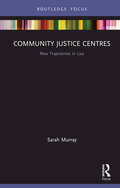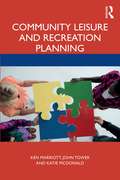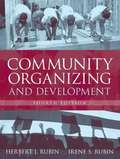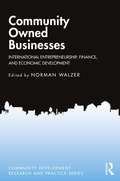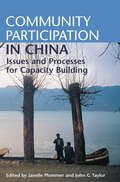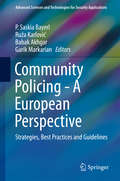- Table View
- List View
Community Development in Asia and the Pacific (Routledge Studies in Development and Society)
by Manohar S. PawarThere is a tremendous need for community development practice in the Asia-Pacific region due to its size and prevailing diverse socio-economic, political and cultural needs and issues. Both developed and developing countries have been reemphasizing the importance of community development and have introduced several schemes or programs for overall development. Manohar Pawar familiarizes readers with the region, presents the major social, economic and political issues, looks at values and principles, and critically analyses challenges and shows opportunities for community development practice in the region. This book will allow for anyone interested in community development both at local and global levels – scholars, non-government organizations (NGOs), government organisations, international aid agencies – to gain a broad understating of community development trends in the Asia-Pacific region.
Community Development in Sub-Saharan Africa (Community Development Research and Practice Series)
by Grey Magaiza Savathrie Margie MaistryCommunity Development in Sub-Saharan Africa explores the dynamics of community development thinking, processes, and approaches in contemporary sub-Saharan Africa. This edited collection prioritises how localised community processes foster transformation in resource-poor communities. The book emphasises examples of community resilience and recovery using locally informed approaches that respect local cultures and ways of being. The book further highlights the formative, yet understudied role of community development practice in sub-Saharan Africa, focusing on how local actions are critical in reducing poverty, enhancing local innovations and sustainability, diversifying livelihoods, and strengthening the architecture for transformative futures. The primary audience is scholars and students with interests in community development, history of development, international development, African Studies, and development theorising, as well as community development policymakers and practitioners.
Community Development in an Uncertain World
by Jim IfeCommunity Development in an Uncertain World provides a comprehensive and lively introduction to modern community development. The book explores the interrelated frameworks of social justice, ecological responsibility and post-Enlightenment thinking, drawing on various sources including the wisdom of Indigenous peoples. Recognising the increasing complexity and uncertainty of the times in which we live, Jim Ife promotes a holistic approach to community development and emphasises the different dimensions of human community: social, economic, political, cultural, environmental, spiritual, personal and survival. The first section of the book examines the major theories and concepts that underpin community development. This includes a discussion of core principles: change and wisdom 'from below', the importance of process and valuing diversity. The second section focuses on practical elements, such as community work roles and essential skills. The final chapters discuss the problematic context of much contemporary practice and offer vision and hope for the future.
Community Disaster Recovery: Moving from Vulnerability to Resilience (Organizations and the Natural Environment)
by Deserai A. Crow Elizabeth A. AlbrightDisasters can serve as focusing events that increase agenda attention related to issues of disaster response, recovery, and preparedness. Increased agenda attention can lead to policy changes and organisational learning. The degree and type of learning that occurs within a government organization after a disaster may matter to policy outcomes related to individual, household, and community-level risks and resilience. Local governments are the first line of disaster response but also bear the burden of performing long-term disaster recovery and planning for future events. Crow and Albright present the first framework for understanding if, how, and to what effect communities and local governments learn after a disaster strikes. Drawing from analyses conducted over a five-year period following extreme flooding in Colorado, USA, Community Disaster Recovery: Moving from Vulnerability to Resilience presents a framework of community-level learning after disaster and the factors that catalyse policy change towards resilience.
Community Economic Development (Regions and Cities #Vol. 22)
by Graham HaughtonThis important book examines the ways in which community economic development can contribute to local and regional regeneration. It presents a unique overview of the state of contemporary British practice in this important policy area and provides a series of fresh, theoretical, methodological and empirical insights which help us to understand ways in which communities are facing up to the challenges of devising and bringing about their own revitalisation. Community Economic Development is underpinned by the argument that much conventional regeneration work represents at best a short-term fix rather than a long-term sustainable solution to the problems of socially excluded communities. The emphasis of the book is largely on the British experience with contributions from a rich mix of new and established academics and practitioners.
Community Economic Development in Social Work
by Cathy Nancy Steven D. Soifer Mcneely Joseph B. Costa Pickering-BernheimThis cutting-edge text explores the intersection of CED and social work practice
Community Economic Development in Social Work
by Cathy Costa Joseph B. Mcneely Nancy Pickering-Bernheim Steven D. SoiferThis cutting-edge text explores the intersection of CED and social work practice
Community Economic Development in Social Work (Foundations of Social Work Knowledge Series)
by Cathy Costa Nancy Pickering-Bernheim Steven Soifer Joseph McNeelyCommunity economic development (CED) is an increasingly essential factor in the revitalization of low- to moderate-income communities. This cutting-edge text explores the intersection of CED and social work practice, which both focus on the well-being of indigent communities and the empowerment of individuals and the communities in which they live. This unique textbook emphasizes a holistic approach to community building that combines business and real-estate development with a focus on stimulating family self-reliance and community empowerment. The result is an innovative approach to rehabilitating communities in decline while preserving resident demographics. The authors delve deep into the social, political, human, and financial capital involved in effecting change and how race and regional issues can complicate approaches and outcomes. Throughout, they integrate case examples to illustrate their strategies and conclude with a consideration of the critical role social workers can play in developing CED's next phase.
Community Economic Development in the United States: The CDFI Industry and America’s Distressed Communities
by James L. Greer Oscar GonzalesThis is the first scholarly analysis that examines the development and achievements of the American community development movement. Community development is now a multi-billion industry in the US. Hundreds of Community Development Financial Institutions (CDFIs), located in all regions of the country, have successfully forged locally-based strategies that provide affordable housing, foster business development, and provide much needed community facilities, including innumerable charter schools, in highly distressed communities in inner city neighborhoods, rural communities, and also in American Indian areas. In many areas of the US, CDFIs represent a viable alternative to the mainstream banking industry. This volume documents the positive impact the CDFI industry has had in distressed urban and rural areas in the US.
Community Empowerment, Sustainable Cities, and Transformative Economies
by Jacob Wood Taha ChaiechiThis edited volume presents the conference papers from the 1st International Conference on Business, Economics, Management, and Sustainability (BEMAS), organized by the Centre for International Trade and Business in Asia (CITBA) at James Cook University.This book argues that the orthodox methods of external risks, climate change adaptation plans, and sustainable economic growth in cities are no longer adequate. These methods, so far, have not only ignored the ongoing structural changes associated with economic development but also failed to account for evolving industries’ composition and the emergence of new comparative advantages and skills. Specifically, this book looks at the vulnerable communities and exposed areas, particularly in urban areas, that tend to experience higher susceptibility to external risks (such as climate change, natural disasters, and public health emergencies) have been largely ignored in incremental adaptation plans. Vulnerable communities and areas not only require different adaptive responses to climate risk but also possess unlocked adaptive capacity that can motivate different patterns of sustainable development to achieve the goals of the 2030 Agenda. It is essential, therefore, to view transformative growth and fundamental reorientation of economic resources as integral parts of the solution. Social disorganisation and vulnerability are other undesired outcomes of the unpredictable and widespread external economic shocks. This is due to a sudden and tough competition between members of society to acquire precious resources, most of which may be depleted during unprecedented events such as natural disasters or pandemics resulting in an even more chaotic and disorganised conditions.
Community Energy and Sustainable Energy Transitions: Experiences from Ethiopia, Malawi and Mozambique
by Vanesa Castán BrotoThis open access book engages with the difficulties of delivering community energy in practice, building on practical experiences in Ethiopia, Malawi, and Mozambique. In these countries, where many people lack access to electricity, community energy is an alternative to advance universal energy access. This book argues that, besides providing access, community energy is essential for achieving justice and resilience in sustainable energy transitions. Community energy combines off-grid infrastructures with innovative forms of governance to incorporate the perspectives of beneficiaries in the generation and distribution of electricity. Community energy has multiple benefits for communities, such as facilitating the adoption of renewable technologies, providing energy access where it is lacking, and building resilience. They also offer societal benefits beyond beneficiary communities, such as providing additional capacity to existing grids, delivering off-grid services where the grid is absent, and bridging on-grid and off-grid systems. Despite its promises, however, the adoption of community energy has been slow. This book presents a feminist-informed perspective on community energy to advance energy justice that puts disadvantaged communities at the centre of sustainable energy transitions. It also explores the room for manoeuvre within existing regulatory systems, supply chains, and delivery systems to facilitate its development. By engaging with existing experiences in community energy, the book demonstrates the potential of communities to gain control over their energy needs and resources and argues for the need to develop a wide range of transdisciplinary skills among policymakers, technicians and communities to deliver a just energy transition.
Community Futures, Legal Architecture: Foundations for Indigenous Peoples in the Global Mining Boom
by Marcia Langton Judy LongbottomHow are indigenous and local people faring in their dealings with mining and related industries in the first part of the 21st century? The unifying experience in all the resource-rich states covered in the book is the social and economic disadvantage experienced by indigenous peoples and local communities, paradoxically surrounded by wealth-producing projects. Another critical commonality is the role of law. Where the imposition of statutory regulation is likely to result in conflict with local people, some large modern corporations have shown a preference for alternatives to repressive measures and expensive litigation. Ensuring that local people benefit economically is now a core goal for those companies that seek a social licence to operate to secure these resources. There is almost universal agreement that the best use of the financial and other benefits that flow to indigenous and local people from these projects is investment in the economic participation, education and health of present generations and accumulation of wealth for future generations. There is much hanging on the success of these strategies: it is often asserted that they will result in dramatic improvements in the status of indigenous and local communities. What happens in practice is fascinating, as the contributors to this book explain in case studies and analysis of legal and economic problems and solutions.
Community Governance and Citizen-Driven Initiatives in Climate Change Mitigation (Routledge Advances in Climate Change Research)
by Jens Hoff Quentin GaussetOne of the most heartening developments in climate change mitigation in recent years has been the increasing attention paid to the principle of ‘thinking globally and acting locally’. The failure of the international community to reach significant global agreements on the reduction of greenhouse gas emissions has led local governments, environmental organisations and citizens themselves to focus increasingly on the local possibilities for action on climate change. This book analyses the strengths and weaknesses of the co-production of climate policies that take place where citizen engagement and local initiatives converge with public agencies. Case studies from Northern Europe, Australia/New Zealand and the USA reveal that traditional individualist approaches to promoting environmental behaviour epitomised by information campaigns and economic incentives cannot trigger the deep behavioural changes required to materially improve our response to climate change. Only by marshalling the forces of thousands, and eventually millions of citizens, can we manage to reach environmental sceptics, reinforce political action and create the new social norms that are sorely needed in our local, and global, response to climate change. This book will be of great relevance to scholars and policy makers with an interest in climate change politics and governance, community engagement and sustainable development.
Community Health Workers in Zambia: Incentive Design and Management
by Natalie Kindred Nava AshrafThis case examines the various considerations relevant to selecting and compensating workers in a context where their work involves a pro-social component. This is relevant to not only health care in Zambia, but to NGO and public sector workers who are both motivated by the mission of their positions and the remuneration. Zambia was facing a healthcare human resource crisis with less than half of the healthcare workers needed to meet health needs. Yet, it was simultaneously burdened by high incidence of diseases such as HIV/AIDS, TB, malaria, malnutrition, and respiratory and diarrheal diseases. The Zambian Ministry of Health (MoH) realized that in the short term, it would be impossible to train the number of doctors and nurses needed to fill this gap. Thus, they were considering incorporating the primarily volunteer community health worker (CHW) force into salaried health workers of the MoH. Given the high level of personal commitment and dedication combined with the proper education and skill needed to be an effective community health worker, the MoH was struggling to identify the best strategy to recruit and retain motivated and capable CHWs.
Community Identity and Political Behavior
by Mary R. AndersonSocial scientists are motivated to understand how various facets of society influence all sorts of behavior. Individual's perceptions about their significance in a given community can have meaningful effects on the way in which we look to communities to develop and foster democratic values and promote civic engagement. The focus of this book is on how community comes to influence political behavior; it takes an interdisciplinary approach blending the fields of community psychology, sociology, and political science. We know from previous research that the context in which an individual interacts influences his/her political behaviors and attitudes. With this in mind, the present research addresses two major questions, 1) how does sense of community influence political behavior and attitudes? and 2) what impact - if any - does involvement in multiple contexts have on political behavior and attitudes?
Community Is Your Currency: 10 Steps to Creating A Thriving Online Community & Growing Your Business
by Daisy MorrisAre you looking to supercharge your business and grow your online community? The key to a booming business is your community. Founder of social media consultancy The Selfhood, Daisy Morris, is here with the ultimate guide for all the side-hustlers, creators, business owners and freelancers looking to build a genuine community on social media. This book drops the jargon - Daisy will teach you how to take your community on a journey. From brand awareness through to conversion, you will have the confidence to expand your reach while nurturing your existing fans, followers, subscribers and customers to turn them in to loyal and repeat customers. You will learn how to create meaningful connections with your audience, through real-life case studies, simple exercises and top-notch business advice. A must-read for any business owner.
Community Is Your Currency: 10 Steps to Creating A Thriving Online Community & Growing Your Business
by Daisy MorrisAre you looking to supercharge your business and grow your online community? The key to a booming business is your community. Founder of social media consultancy The Selfhood, Daisy Morris, is here with the ultimate guide for all the side-hustlers, creators, business owners and freelancers looking to build a genuine community on social media. This book drops the jargon - Daisy will teach you how to take your community on a journey. From brand awareness through to conversion, you will have the confidence to expand your reach while nurturing your existing fans, followers, subscribers and customers to turn them in to loyal and repeat customers. You will learn how to create meaningful connections with your audience, through real-life case studies, simple exercises and top-notch business advice. A must-read for any business owner.
Community Is Your Currency: 10 Steps to Creating A Thriving Online Community & Growing Your Business
by Daisy MorrisA 10-step guide to cultivating a thriving online community and growing your business by the founder of social media consultancy and digital community The Selfhood.Are you looking to supercharge your business and grow your online community? The key to a booming business is your community. Founder of social media consultancy The Selfhood, Daisy Morris, is here with the ultimate guide for all the side-hustlers, creators, business owners and freelancers looking to build a genuine community on social media. This audiobook drops the jargon - Daisy will teach you how to take your community on a journey. From brand awareness through to conversion, you will have the confidence to expand your reach while nurturing your existing fans, followers, subscribers and customers to turn them in to loyal and repeat customers. You will learn how to create meaningful connections with your audience, through real-life case studies, simple exercises and top-notch business advice. A must-listen for any business owner.(P)2023 Hodder & Stoughton Limited
Community Justice Centres: New Trajectories in Law (New Trajectories in Law)
by Sarah MurrayThis book examines the phenomenon of Community Justice Centres and their potential to transform the justice landscape by tackling the underlying causes of crime. Marred by recidivism, addiction, family violence, overflowing courtrooms, crippling prison spending and extreme rates of incarceration, the criminal justice system is in crisis. Community Justice Centres seek to combat this by tackling the underlying causes of crime in a particular neighbourhood and working with local people to redesign the experience of justice and enhance the notion of community. A Community Justice Centre houses a court which works with an interdisciplinary team to address the causes of criminality such as drug addiction, cognitive impairment, mental illness, poverty, abuse and intergenerational trauma. The community thus becomes a key agent of change, partnering with the Centre to tackle local issues and improve safety and community cohesion. This book, based on research into this innovative justice model, examines case studies from around the world, the challenges presented by the model and the potential for bringing its learnings into the mainstream. This book will appeal to academics in law and criminology as well as psychology; it will also be of considerable interest to people working in the criminal justice system, including the police, government policy advisers, psychologists and social workers.
Community Leisure and Recreation Planning
by Ken Marriott John Tower Katie McDonaldCommunity Leisure and Recreation Planning offers an up-to-date, evidence-based approach to planning community leisure and recreation facilities, programs and services. It introduces readers to key theory and best practice in the planning of effective leisure and recreation projects. The book defines planning, leisure, recreation and other key concepts and explains why a thorough planning process is essential to achieving effective outcomes. It presents a comprehensive, integrative four phase model for undertaking leisure and recreation planning, including: pre-planning, planning research, preparing a plan, and implementing, monitoring and evaluating the outputs and outcomes of a plan. It provides a conceptual rationale for each component of the planning process, a detailed explanation of the tools and techniques that can be used, and extensive examples and international case study materials to demonstrate their use. The principles and techniques explained in the book are applicable at a range of community levels from small individual sites to regions, states and even countries. This is an essential course text for all leisure and recreation courses, and invaluable reading for academics, practitioners, stakeholders and students working in leisure and recreation planning, events, culture and sport.
Community Organizing and Development
by Irene S. Rubin Herbert J. RubinThis revised edition of a well-known and widely used text in community organizing and development fully examines the broad and changing political and social settings that influence actions; while portraying the infra-structure of social change -- the knowledge, personnel, and organizations -- that enable such work to be successfully accomplished. The text brings together the practicalities of organizing and development -- fund raising, working out news releases, running an organization, orchestrating political actions, academic knowledge -- and explains why various approaches work; as well as the values and ideologies that guide what is to be done. It provides the foundations of organizing and development work and then describes how activists -- through following either a social confrontation model or an economic and social production approach -- can respond to economic and social problems.
Community Owned Businesses: International Entrepreneurship, Finance, and Economic Development (Community Development Research and Practice Series)
by Norman WalzerThis book analyses community-owned businesses in countries around the world to show successful approaches and important strategies to improve access to essential services in vastly different economic contexts. Through eleven chapters, authors from various countries use case studies and analyse findings in ways which can be applied to new development initiatives, including rural grocery store retention in Kansas, socially responsible community cooperatives in Italy, preserving pubs and shops in England and Wales, serving residents with special needs in Canada, and financing basic goods and services for aging populations in Taiwan, plus other examples. The chapters explore practices and approaches used in various locations to address concerns about loss of access to essential services, making clear that this approach to financing is useful in different scenarios. The chapters provide key insights suggesting that these approaches will be even more prevalent in the future and will be of interest to students, scholars, and community-development practitioners around the world.
Community Participation in China: Issues and Processes for Capacity Building
by John G. Taylor Janelle PlummerThis important volume provides a source of information on the key issues, including constraints and capacity building, necessary to implement participatory approaches in China today. A wealth of case studies are provided by principal Chinese academics and practitioners in forestry, natural resource management, rural development, irrigation and poverty alleviation. At the core, the book is about strengthening local government as a key player in the development of participatory initiatives. It is an invaluable text for development practitioners, donors, researchers and students seeking to understand the opportunities and constraints for participation in China, and for those working to institutionalize participatory processes in a complex rural context.
Community Policing - A European Perspective: Strategies, Best Practices and Guidelines (Advanced Sciences and Technologies for Security Applications)
by Babak Akhgar P. Saskia Bayerl Ruža Karlović Garik MarkarianThis book provides a view into the multi-dimensional and multi-contextual nature of community policing. It brings together important conceptual discussions as well as numerous case studies and real-life examples of European community policing practices. It further offers insights into how the (primarily locally focused) concept of community policing fits into an increasingly interconnected world. Our book is intended for professionals working in community policing, academics and policymakers developing community policing procedures. In addition, the book aims to provide information for readers who are new to the subject of community policing. The wide range of examples and case studies make it also an excellent resource for teaching materials.
